
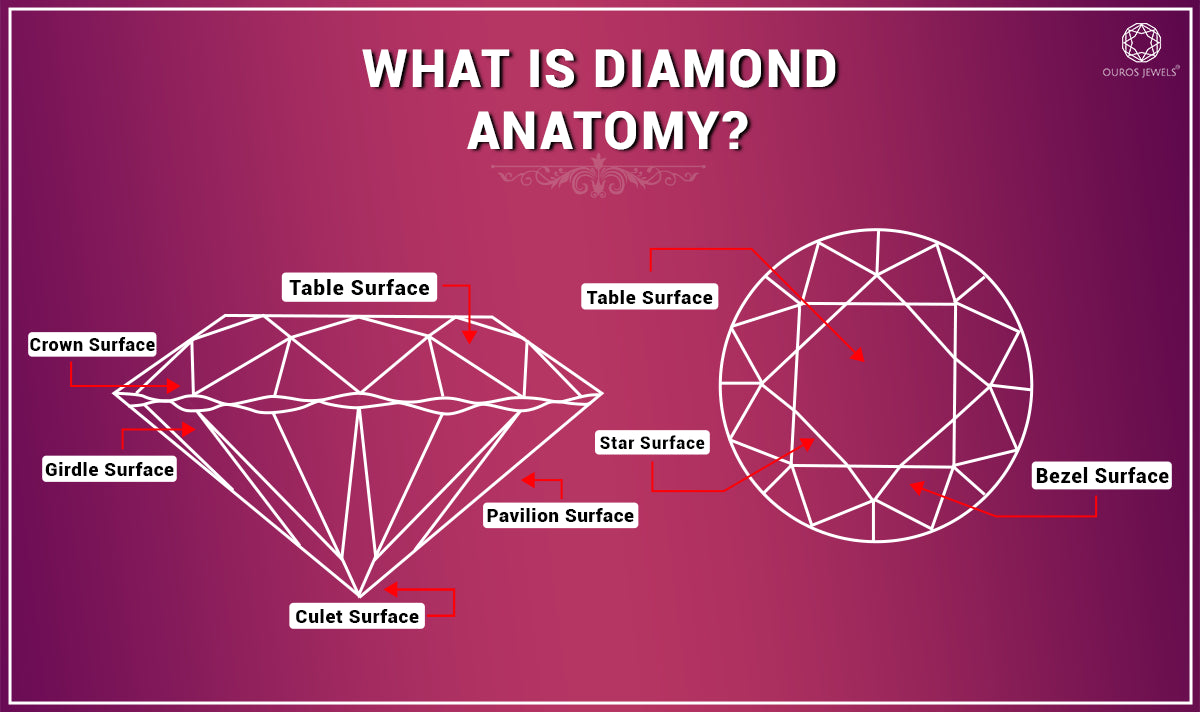
Diamond Anatomy Definition and Guide

Diamond Anatomy represents the framework or structure that craftsmen create on the grading wheel. Diamond Anatomy is not just an indicator of a diamond's part but suggests whether you choose a diamond or not. In Diamond Anatomy Table, Culet, Crown, Pavilion, and Girdle are included.
Here in this case, anatomy is the organ of the diamonds. If you know diamond anatomy, you can easily deal with diamond manufacturers for your choice of diamond.
Table of contents
What is diamond's anatomy?
Diamond anatomy is known as below mentioned surfaces in gemological terms(Diamond Checker):- Diamond anatomy includes table, crown, girdle, pavilion, and culet surfaces.
From anatomy, the grade of the diamond has decided. Diamond anatomy is the indicator of how well stone can be sparkle, the durability stage, and craftsmanship level. Read below the information regarding diamond anatomy.
1. Table Surface = Center place of the diamond. It's first place where the light enters to the surface.
2. Crown Surface = Crown surface is the place around the table surface carries the triangle and cube-shaped facets. It is in the curving and banding shape.
3. Girdle Surface = After crown surface, the thin facets are covered up, and it interacts with the pavilion and crown surface to complete the length. It is called a girdle surface.
4. Pavilion Surface = Diamond pavilion surface connects all faceting lines in straight triangle lines in one place. The pavilion comes after the girdle part, and the it has more width and length than the table surface.
5. Culet Surface= The diamond culet surface is known as the leg of the diamond, which helps to diamond the stand. It has a sharp edge, and facets are gathered on the culet surface, and from here, all light returns as sparkle.
Unfortunately, Lab-Grown Diamonds and Natural Diamonds have identical anatomies.
Diamond’s body parts or anatomies are divided into five divisions. So let us start to explore diamond anatomy. The diamond part's names are as follows from ascending to descending pattern.
The first part is the table. The second is the crown surface. The third number surface is famous as the “girdle,” while the fourth part is known as the “Pavillion.” The final and bottom part of the diamond represents the sharp edge which is called the “Tick Point or Culet.”
So, let’s start to explore the diamond’s anatomy in brief and accurate detail.
What is diamond table surface in anatomy?
![[Diamond table surface appearance]-[ouros jewels]](https://cdn.shopify.com/s/files/1/0527/7669/8040/files/Diamond_Anatomy_Project_Post_2022_Pear_Diamond_copy_3_480x480.jpg?v=1655467144)
A table surface in anatomy is known for its sparkle ability on the eyes. From the top view of the diamond at the center place, square shaped faceting available which called as table anatomy. The table surface has a clear appearance, and on it, no single faceting is placed because it's the most important part of the diamond.
If the diamond has some nuance-like impurities, the table surface helps you see the impurities or inclusions. At the top view of the diamond table surface, you see there many faceting lines matched from east to west and south to north.
We recommend choosing only traditional cut diamonds with exact proportions on the table surfaces. Also, you can try antique shapes of lab-grown diamonds to fulfill a wish to wear different faceting style diamonds. In table surface, many other shapes are matched together from different corners.
In short, diamond’s table surfaces represent the overall appearance of the craftsmanship. If the faceting line doesn’t match at their exact place, you can say that diamond’s proportion cutting and polishing process is not done well.
The crown surface of the diamond anatomy.
![[Crown surface of the diamond anatomy]-[ouros jewels]](https://cdn.shopify.com/s/files/1/0527/7669/8040/files/Diamond_Anatomy_Project_Post_2022_Pear_Diamond_copy_2_1_480x480.jpg?v=1655524559)
The diamond crown surface has a 15-45° curved edge between the girdle and table surface. In crown surface elegant faceting style placed which provides push to sparkling light to reflect on eyes. Crown surfaces has triangle and heart shaped faceting on the anatomy which helpful to identify the diamond inclusion.
The crown surface tells how the diamond will spark from east to west or north to south from the top view. The diamond crown surface is very important for easily fitting in prongs-style engagement rings. All circumference of a diamond is covered by the crown surface.
The crown surface is the most important factor or part of the sparkling lights. We can’t imagine a diamond’s sparkle or flashing ability without a crown surface. In addition, you see that the table surface has a flat aspect while the crown surface features a curved surface facet.
Finally, when you look at the round-cut diamond or cushion diamond, you notice that the crown surface has been placed between the girdle and the table surface.
When light enters through table surfaces, a crown surface catches and stores the light in its textures. At the same time, the bottom of a diamond part fires the sparkle; then, the crown releases its held lights with the 5X more blazing ability with it. So, the crown part is the leading factor in the diamond's thundering sparkly appearance.
The girdle anatomy of the diamond.
A girdle surface of the diamond anatomy simply represents facets that are helping to release better sparkling lights through the surface. In girdle surface, all of the crown and pavilion facets are gathered with a triangle and tie shaped pattern.
Also, a girdle was created between the crown and pavilion faceting on the diamond polishing process. Girdle diamonds mean that the structure of the stone is covered by the facets and space, which is an essential part of the bright appearance if exactly placed.
What is the process for faceting the girdle anatomy?
![[Girdle anatomy and its faceting placements]-[ouros jewels]](https://cdn.shopify.com/s/files/1/0527/7669/8040/files/Diamond_Anatomy_Project_Post_2022_Pear_Diamond_480x480.jpg?v=1655467416)
When the polish worker puts a rough diamond on the grading running wheel, then he holds the stone in the equipment with soft hands. After putting the diamond on the running wheel, he softly surpasses the girdle surface with a 360° degree level on the running wheel for giving or design like a mountain. Making a girdle surface is very hard and challenging.
A tiny mistake will be a major economic hit for the manufacturer. Also, the diamond girdle part’s faceting lines are matched with the crown and pavilion facets.
A slightly thin girdle diamond means that a faceting is wider than its actual size, affecting the light reflection. In a slightly thick girdle diamond, the faceting patterns don't look good and best but still release less amount of sparkle from there.
The girdle part of the diamond is deciding factor of the cut. Diamond cut helps the anatomies to get a sparkles lights and store it. While the time is come for the reflections then it will be release the sparkles with full of pressure.
1. Excellent cut diamond:- Very thin and stylish girdle faceting work has been done.
2. Very good cut diamond:- In a very good cut diamond, the girdle is slightly thick than excellent cut diamond.
3. Good cut diamond:- Good cut diamond has a more wide girdle than an excellent cut diamond for matching other parts. Recommend for emerald, cushion, and pear diamond in good cut.
4. Fair cut diamond:- In fair cut diamond, girdle surface has more thickness than a good cut diamond.
5. Poor cut diamond:- When a diamond girdle has extremely thickness, it is known as a “poor cut diamond.”
What does the diamond pavilion represent in anatomy?
![[Diamond pavilion anatomy appearance]-[ouros jewels]](https://cdn.shopify.com/s/files/1/0527/7669/8040/files/Diamond_Anatomy_Project_Post_2022_Pear_Diamond_copy_4_480x480.jpg?v=1655467514)
A pavilion anatomy is located under the girdle anatomy. A diamond pavilion looks like a belly or stomach of the stone because it is wider and has depth that store the light reflections. Thus, the sparkle reflections are depends on the pavilion depth and how carefully the facets are place.
The pavilion surface is the most affecting factor of diamond appearance. If you purchase the diamond, then look at the pavilion facets. If all pavilion’s parts don't match each surface of the diamond, then you tell that the diamond could have a manufacturing defect or originated fault. Diamond pavilion facets are responsible for beautiful brightening.
The diamond's culet or tick point expose.
![[Diamond culet is the most essential part of the stone]-[ouros jewels]](https://cdn.shopify.com/s/files/1/0527/7669/8040/files/Diamond_Anatomy_Project_Post_2022_Pear_Diamond_copy_480x480.jpg?v=1655467918)
All facets of the diamonds are gathered on their way to the ticking point, and from this point, the lights are reflected in their specific ways. The diamond culet or tick point is the last anatomy of the stone where all entered lights are distributes the shining to outer atmosphere.
The diamond culet is the place where all the faceting patterns match, and from there, they reflect the lights such as diamond fluorescence.
Diamond culet absorbs all the sparkle reflections and releases it from the 360° ways. That's why a diamond culet is a more important factor for the sparkle of the diamonds. So people select sharpened edged diamond culets for their jewelry and rings.
But, when the thing comes to reflection, culet point releases more sparkle than demanded. When the diamond has no sharp or soft edges, then it releases less flash because the main factor(tick point) of the brilliant sparkle is absent there.
If you want to see the culet less diamond, then look at the rose-cut diamonds with no culet or tick point. For a transparent appearance, rose cut diamonds are made.
In descending order, a culet or tick point is the first part of diamond anatomies. In many shapes of diamond, culet has softness like Emerald, cushion, oval, and radiant. In comparison, round shape, pear cut, and heart diamonds have sharp edges or tick points.
When external light enters the culet area, it reflects 16X more sparkles if it is cut with extra care and skill. So ever, you look at the spring; if we pressure it, then it releases with 10-20X better power. So in diamond anatomy, the ticking point or culet plays a role as spring in looks.
Conclusion
Now you have understood what diamond anatomy is. In diamond anatomy, the decision for purchasing depends because if any anatomy is mismatched, then the appearance does not look fair. That's why if you want to get an exactly placed anatomy diamond for your engagement ring or whenever you want to use it, then visit our lab-grown diamonds section.
Ouros jewels has brilliant cut diamonds, rose cut diamonds, salt & pepper diamonds, and antique cut diamonds with exact anatomy portions. That's why once time purchase it.
FAQ's
Q1. What is Diamond Anatomy?
Ans. Diamond anatomy refers to the structural components of a diamond, which include the table, crown, girdle, pavilion, and culet. These features guide how well a diamond reflects light, which affects its brilliance and overall look.
Q2. What are the primary parts of diamond anatomy?
Ans. The primary parts of diamond anatomy are:
- Diamond Table: refers to the diamond's top flat surface.
- Diamond Crown: is the diamond's top section, above the girdle.
- Diamond Girdle: is the diamond's central part that separates the crown and pavilion.
- Diamond Pavilion: is the diamond's lowest section, located under the girdle.
- Diamond Culet: A tiny point or facet near the base of the pavilion.
Q3. How Does the Girdle Affect a Diamond's Appearance?
Ans. The girdle is important because it affects how light is reflected within the diamond. Its thickness can influence the diamond's brilliance and stability in its setting.
Q4. What is a Diamond's Table, and why does it are important?
Ans. The table is the biggest facet of a diamond, positioned at the top. It is significant because it is the principal entry point for light into the diamond, which affects how light is distributed throughout the stone.
Q5. Can a diamond's crown affect its overall sparkle?
Ans. Absolutely. The angle and height of the crown guide how light interacts with the table and pavilion, affecting the diamond's brilliance and dispersion of light.
Q6. What is the Importance of the Pavilion in a Diamond?
Ans. The pavilion has an important function in light reflection. Its depth and angles influence how light bounces inside the diamond, changing its brilliance and fire.
Q7. Does the Culet Size Affect a Diamond's Sparkle?
Ans. Yes, the size of the culet may influence a diamond's sparkle. A wide culet may enable light to escape from the bottom of the diamond, reducing brilliance, whereas a little or no culet maximizes light return.
Recent Blogs
-
The Complete Guide to Lab-Grown Diamonds: Ethical Luxury for the Modern Couple December 24, 2025
-
December 20, 2025
-
December 16, 2025
-
December 11, 2025
-
November 15, 2025

 Solitaire Rings
Solitaire Rings

 Halo Rings
Halo Rings

 Bezel Rings
Bezel Rings

 Three Stone Rings
Three Stone Rings

 Five Stone Rings
Five Stone Rings

 Bridal Set Rings
Bridal Set Rings

 Solitaire Accent Rings
Solitaire Accent Rings

 Toi Moi Rings
Toi Moi Rings

 Semi Mount Rings
Semi Mount Rings

 Custom Rings
Custom Rings
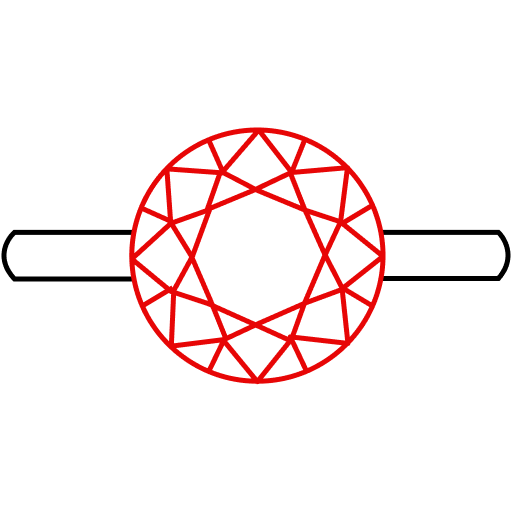
 Color Diamond Rings
Color Diamond Rings

 Lab Gemstone Rings
Lab Gemstone Rings

 Men's Rings
Men's Rings

 Round
Round

 Pear
Pear

 Oval
Oval

 Princess
Princess

 Asscher
Asscher

 Marquise
Marquise

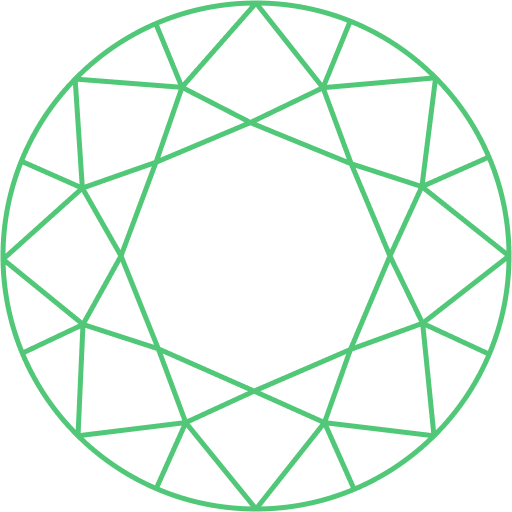 Emerald
Emerald

 Cushion
Cushion

 Radiant
Radiant

 Heart
Heart

 Old Cuts
Old Cuts
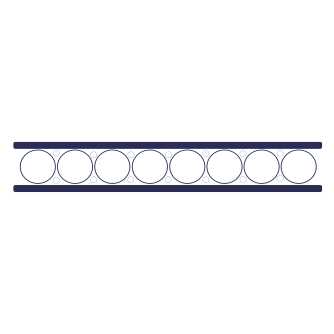
 Eternity Bands
Eternity Bands

 Dainty Bands
Dainty Bands

 Custom Bands
Custom Bands

 Men’s Bands
Men’s Bands
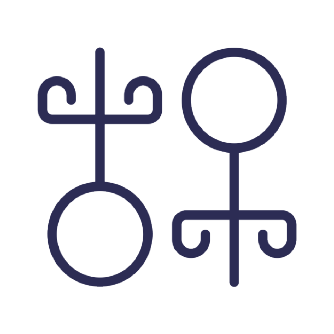
 Studs
Studs

 Hoops
Hoops

 Jackets
Jackets

 Dangle
Dangle

 Bridal
Bridal

 Tennis Bracelet
Tennis Bracelet

 Fashion Bracelet
Fashion Bracelet
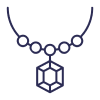
 Pendant
Pendant

 Necklace
Necklace
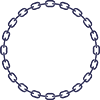
 Men's Jewelry
Men's Jewelry
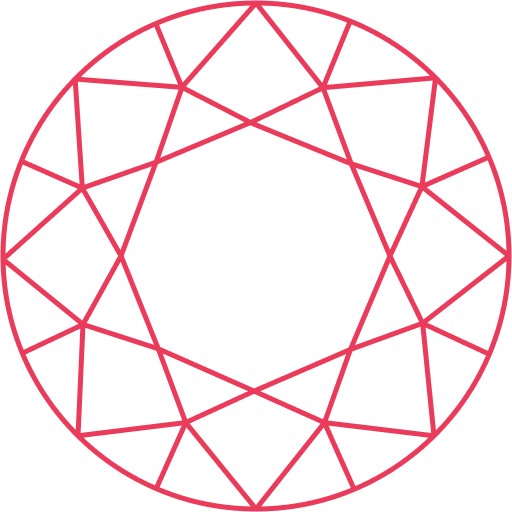
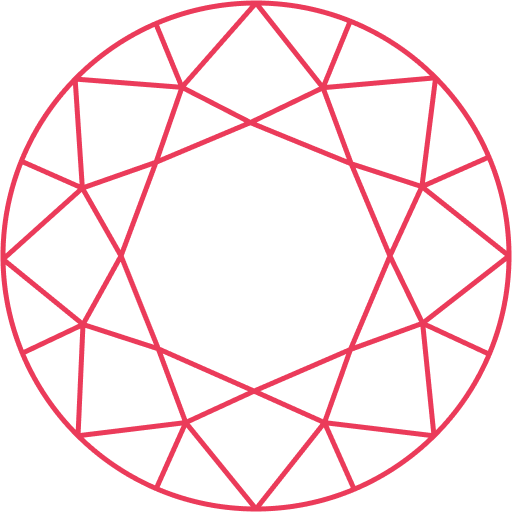 Pink
Pink

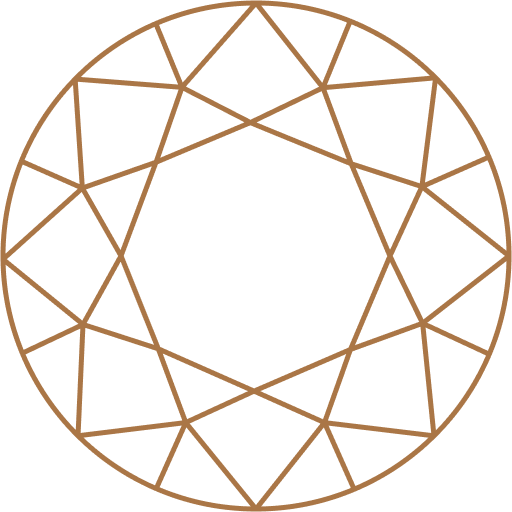 Champagne
Champagne

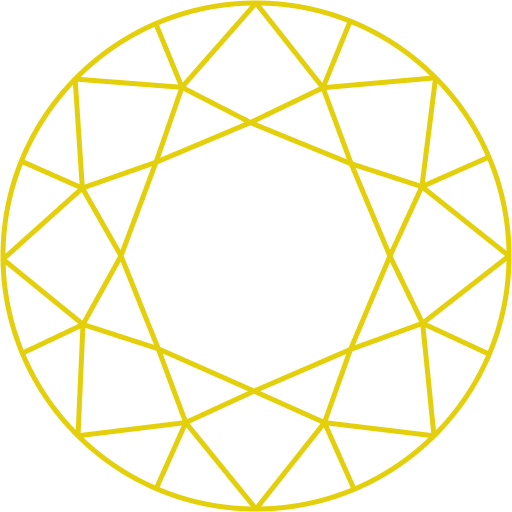 Yellow
Yellow

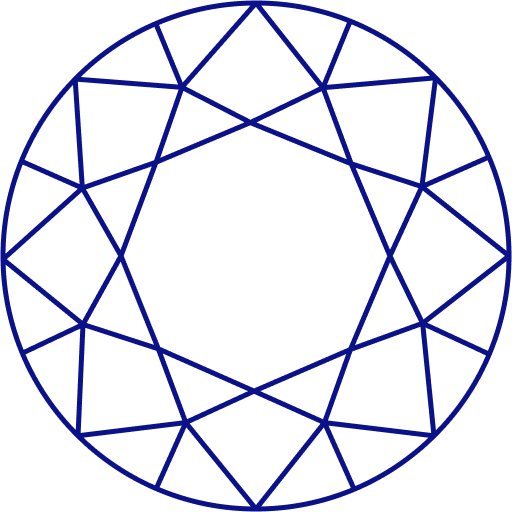 Blue
Blue

 Black
Black

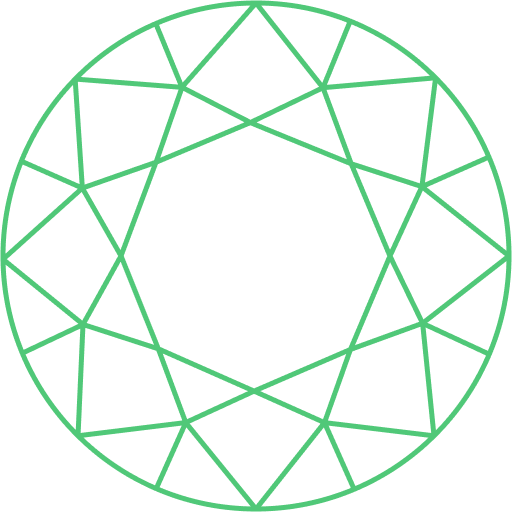 Green
Green

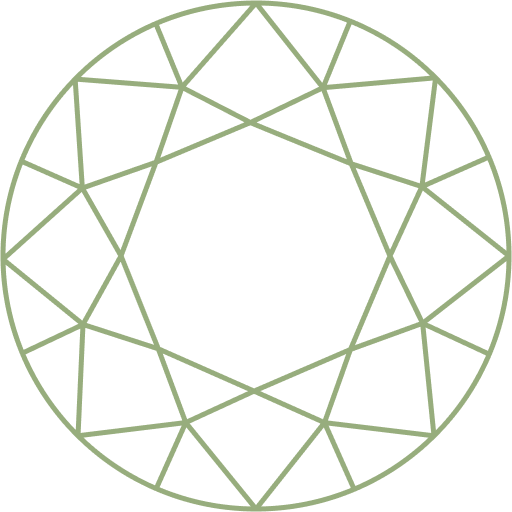 Olive
Olive

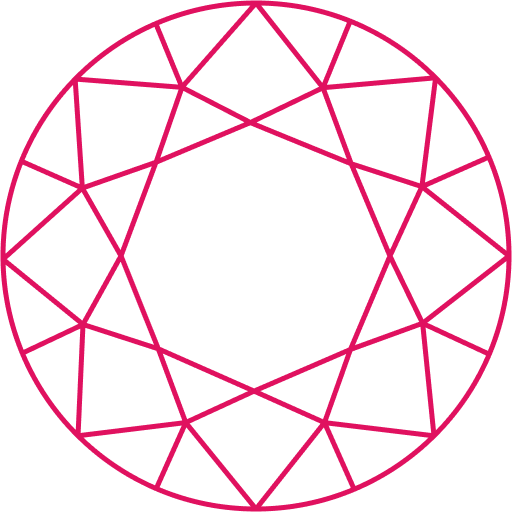 Ruby
Ruby

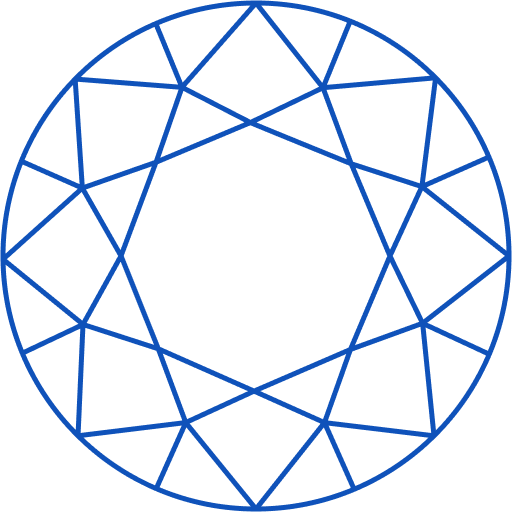 Sapphire
Sapphire

 Other Gemstone
Other Gemstone

 Old Cut Jewelry
Old Cut Jewelry
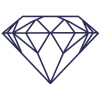
 Antique Diamond Jewelry
Antique Diamond Jewelry

 Kids Collection
Kids Collection

 Celebrity Jewelry
Celebrity Jewelry

 Old Cut
Old Cut

 Antique Cut
Antique Cut

 Matching Pair
Matching Pair
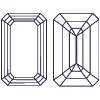
 Step Cut
Step Cut
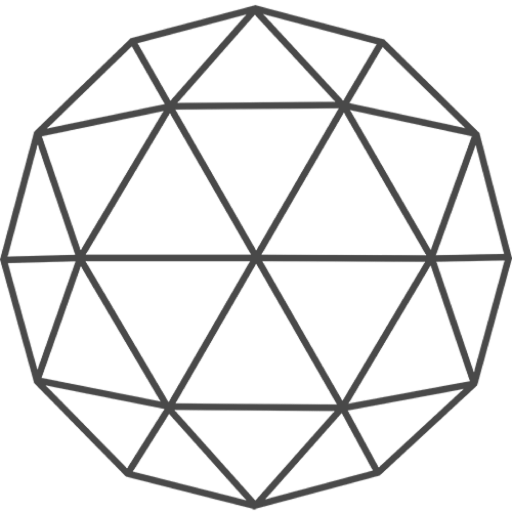
 Rose Cut
Rose Cut

 Portuguese Cut
Portuguese Cut

 Portrait Cut
Portrait Cut

 Pie Cut
Pie Cut

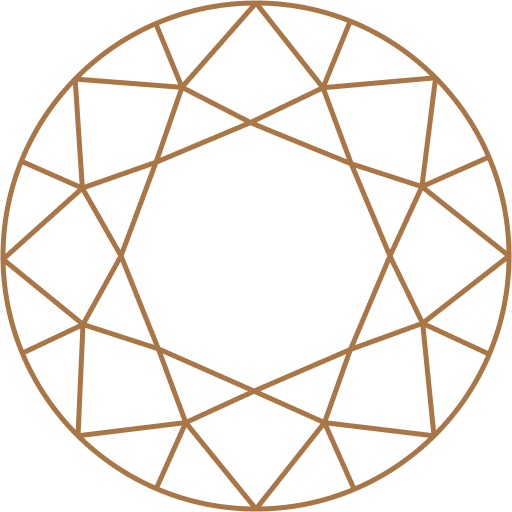 Champange
Champange

 Other
Other

 IGI-GIA Certified
IGI-GIA Certified

 8X Diamond
8X Diamond

 Ready Stocks
Ready Stocks

 OEC Round
OEC Round

 Old Mine Cushion
Old Mine Cushion

 Old Mine Moval
Old Mine Moval

 Old Mine Emerald
Old Mine Emerald

 Old Mine Asscher
Old Mine Asscher

 Old Mine Pear
Old Mine Pear

 Old Mine Heart
Old Mine Heart

 Rings
Rings

 Bands
Bands

 Earrings
Earrings

 Bracelets
Bracelets

 Anniversary Gift
Anniversary Gift

 Birthday Gift
Birthday Gift

 Gift For Her
Gift For Her

 Gift For Him
Gift For Him

 Under 300$
Under 300$

 Under 500$
Under 500$






